
scrounge: /skrounj/ informal verb: to actively seek [books] from any available source
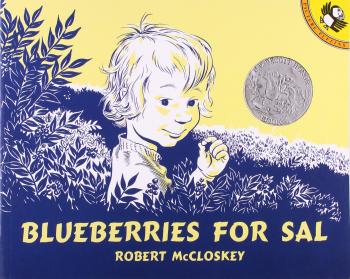
This classic has been on my bookshelves for as long as I can remember, and is not only a wonderful children's story but a celebration of one aspect of the wild beauty of my home state of Maine. While Blueberries for Sal never comes out and gives a location (aside from "Blueberry Hill"), it's not difficult to imagine that this story is based in Maine (like several of McCloskey's others), given that Maine is pretty much the world capital for wild blueberries (one of the few fruit crops that's native to North America).
When I came back to this book as an adult, I could remember the gist of the narrative -- how Sal and a baby bear get mixed up, with each following the other's mother (as both mothers are quite focused on their task of finding blueberries for the winter). But what I find most endearing about this book is the way McCloskey's illustrations so perfectly capture the mannerisms of a toddler. Sal is capable of great focus on picking, but also an inability to keep more than three blueberries in her pail without eating them. Whether it's the facial expressions or the overall strap that's perpetually falling off her shoulder, Sal is the epitome of a cute and curious toddler who is satisfied by simple things.
I used this book with my son in pre-k for "B week." After reading it, we ate blueberries and "brown bears" (chocolate teddy grahams) for snack.
Scrounged From: A gift for our child
Format: Hardcover
Author/Illustrator: Robert McCloskey
Pages: 56
Content Advisory: None
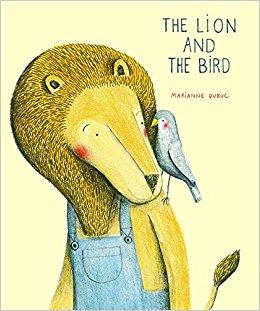
The Lion and the Bird is a beautiful, contemplative story by Montreal author/illustrator Marianne Dubuc, and it was originally published in French. It tells the story of a lion who finds an injured bird in the autumn, and cares for it over the winter. But when spring comes again, the lion understands that the bird has to fly away with the other birds.
One thing I love about the way this tale is told is that it makes space for sadness. Even though the book does leave us with a happy ending, we really feel the loss the lion feels as he walks sadly back to his house after saying goodbye. We watch him wordlessly trying to go about his daily tasks as usual, with the inescapable awareness that someone special is missing. "Sometimes life is like that," we are told.
Not only is there space for sad emotions, but Dubuc gives space for the tale to be told in the first place. At 64 pages, the book manages to feel complete and well-rounded without being "long." It is not overly wordy either -- the sentences are fairly short and simple, going back and forth between the narrator and words spoken by the lion.
The story itself could be summarized quite easily in a sentence or two, but the author makes use of white space, multiple frames, and also a few wordless pages to convey a linear narrative where even the small moments are important. This also gives space for the adult reader to point things out to a child, or ask questions ("How do you think the lion feels right now?") without disrupting the flow of the story.
This story is brief, yet thorough -- succinct, yet spacious, encompassing a look at each of the four seasons, the sadness of letting go, and the beauty of friendship.
Scrounged From: Our local library
Format: Hardcover
Author/Illustrator: Marianne Dubuc
Pages: 64
Content Advisory: None
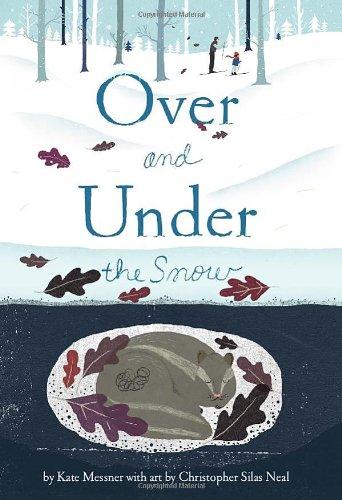
Since we live in a Northern state with long winters and plenty of woods around, Over and Under the Snow is a very relevent book for our climate, but is still an appealing nature book for any child.
The narrative follows a child and parent skiing through the woods, and continually contrasts the visible world that is over the snow with a "hidden kingdom" under the snow, where some animals hibernate, while others eat, sleep, and even make tunnels.
From bull frogs to queen bees, and from deer mice to bears, we are shown a variety of different creatures that spend the winter under the snow, as well as others that spend it above, such as deer and foxes.
One of the best things about this book is the artwork -- lots of earth tones matched with cool wintery blues, which provide a nice contrast to the bright red fox.
At the end the book gives a brief description of each animal mentioned, as well as a list of suggestions for further reading.
Scrounged From: Our local bookstore
Format: Paperback
Author: Kate Messner
Illustrator: Christopher Silas Neal
Pages: 44
Content Advisory: None
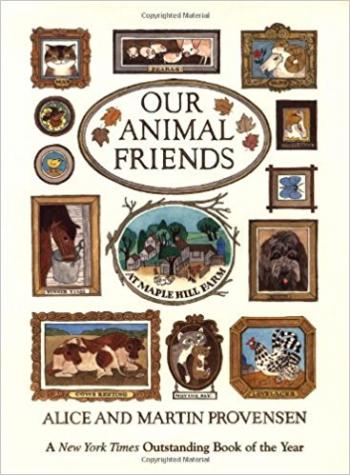
Our Animal Friends at Maple Hill Farm is a book that doesn't have a singular narrative story to it, but works well as a delightful introduction to the animals on a particular farm. You feel as if the farmer has taken you by the hand and led you around, introducing you to the different kinds of animals and telling you their names, as well as pointing out their idiosyncrasies and personality quirks. You feel like you're learning from someone who has developed years of experience and patience in working with animals.
I use the word "delightful" because it really comes across that the author is someone who delights in their animals, even when they are being annoying or difficult to manage. This perspective manages to give the animals respect and dignity (and names) without anthropomorphizing them.
We get to meet the "four special cats," learn what makes each of them unique, and see a few vignettes of what each of them do throughout the day, together or alone.
We learn about how wonderful geese are except for one particular trait: they have bad tempers.
We are told all about the horses and how they interact together. We hear about how Ibn Rafferty hurt his foot, doesn't like to come when he's called, and likes to roll in the mud after he's been cleaned.
We're also told about "other neighbors" on the farm, the non-domesticated animals that stop by once in a while, from chipmunks to hawks, ants, and field mice.
And much more.
It is so fun to get to know the animals on Maple Hill Farm, but even more, this book encourages us to study, observe, and look for the uniqueness in all animals, no matter where they live.
Scrounged From: A present for our kids
Format: Paperback
Authors/Illustrators: Alice and Martin Provensen
Pages: 64
Content Advisory: None
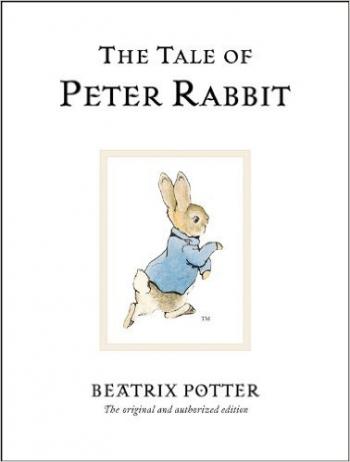
I've grown up with Peter Rabbit, and for a book published more than a century ago, it has held up pretty well, though you'd be hard pressed to find a modern children's story that makes use of quite so many semicolons (if any).
Still, I much prefer the original, with Beatrix Potter's artwork, to any version that attempts to "update" or condense the story in various ways (such as replacing terms like "implored" and "fortnight.") Potter's little hand-drawn characters portray so much warmth, but also the gravity of being proper British rodents -- such as when Peter escapes from almost certain death and his mother's first reaction is to wonder what he did with his clothes. It's all about social survival with these bunnies. In fact, Peter's mother is clearly cut from the same cloth as Mrs. Tabitha Twitchet.
Although it may be too wordy yet for children in the "board book stage," this is still a classic cautionary story of danger and survival that all children should encounter at some point.
Scrounged From: Our local flea market
Format: Paperback
Author/Illustrator: Beatrix Potter
Pages: 62
Content Advisory: Mainly just peril. We learn early on that Peter's father ended up in a pie.


